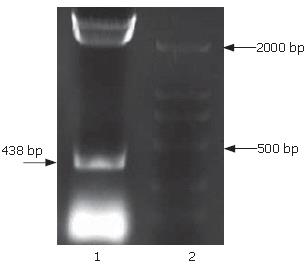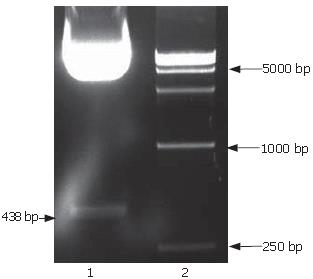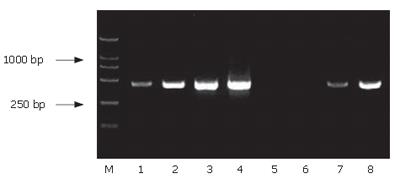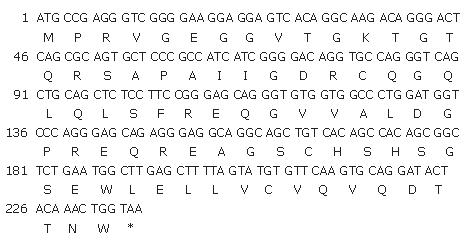Copyright
©2007 Baishideng Publishing Group Co.
World J Gastroenterol. Mar 14, 2007; 13(10): 1602-1607
Published online Mar 14, 2007. doi: 10.3748/wjg.v13.i10.1602
Published online Mar 14, 2007. doi: 10.3748/wjg.v13.i10.1602
Figure 1 PS1TP5 RT-PCR product electrophoresis on 10 g/L agarose gel.
Lane 1: PS1TP5 PCR products; lane 2: DNA marker 2000.
Figure 2 Digestion and identification of the recombinant plasmid pGEM-T-PS1TP5 by EcoRI/BglII.
Lane 1: Restriction analysis of pGEM-T-PS1TP5; lane 2: DNA marker 2000.
Figure 3 Restriction analysis of the recombinant plasmid pcDNA-3.
1(-)-myc-his(A)-PS1TP5 by EcoRI/BglII. Lane 1: Restriction analysis of pcDNA-3.1(-)-myc-his(A)-PS1TP5; lane 2: DNA marker 15 000.
Figure 4 PCR analysis of substraction efficiency.
M: DNA marker 2000; lanes 1-4: PCR of 18, 23, 28, 33 cycles in unsubstracted group, respectively; lanes 5-8: PCR of 18, 23, 28, 33 cycles in substracted group, respectively.
Figure 5 PCR amplification of part of clones (56-63) in substracted cDNA library.
M: DNA marker 2000.
Figure 6 The nucleotide sequence of PS1TP5TP1 gene and relevant amino acid sequences (GenBank accession number: DQ487761).
- Citation: Zhang JK, Zhao LF, Cheng J, Guo J, Wang DQ, Hong Y, Mao Y. Screening and cloning for proteins transactivated by the PS1TP5 protein of hepatitis B virus: A suppression subtractive hybridization study. World J Gastroenterol 2007; 13(10): 1602-1607
- URL: https://www.wjgnet.com/1007-9327/full/v13/i10/1602.htm
- DOI: https://dx.doi.org/10.3748/wjg.v13.i10.1602














